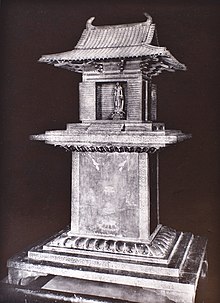



The Tamamushi Shrine (玉虫厨子, Tamamushi no zushi) is a miniature shrine owned by the Hōryū-ji temple complex of Nara, Japan. Its date of construction is unknown, but estimated to be around the middle of the seventh century.[2] Decorated with rare examples of Asuka-period paintings, it provides important clues to the architecture of the time[2][3] and has been designated a National Treasure.[4]
Consisting of a low rectangular dais supporting a plinth upon which stands a miniature building 233 centimetres (7 ft 8 in) tall, the Tamamushi Shrine derives its name from the iridescent wings of the tamamushi beetle with which it was once ornamented, but which have now exfoliated.[2] In spite of what its name in English may suggest, the shrine is not a miniature Shinto shrine, as zushi (厨子) is a term for a miniature shrine that houses Buddhist images or sūtra scrolls,[5] in this case a statue of Kannon and small rows of seated bronze Buddhas.[2]
- ^ Bunkazai Hogo Iinkai, ed. (1963). 国宝 上古, 飛鳥·奈良時代, 西魏·唐 [National Treasures of Japan I: Ancient times, Asuka period, Nara period, Western Wei, Tang] (in Japanese and English). Mainchi Shimbunsha. p. 40.
- ^ a b c d Mizuno Seiichi (1974). Asuka Buddhist Art: Horyuji. Weatherhill. pp. 40–52.
- ^ "Tamamushi no zushi". Japanese Architecture and Art Net Users System. Retrieved 9 March 2012.
- ^ "玉蟲厨子" [Tamamushi Shrine]. Agency for Cultural Affairs. Retrieved 9 March 2012.
- ^ "Zushi". Japanese Architecture and Art Net Users System. Retrieved 9 March 2012.